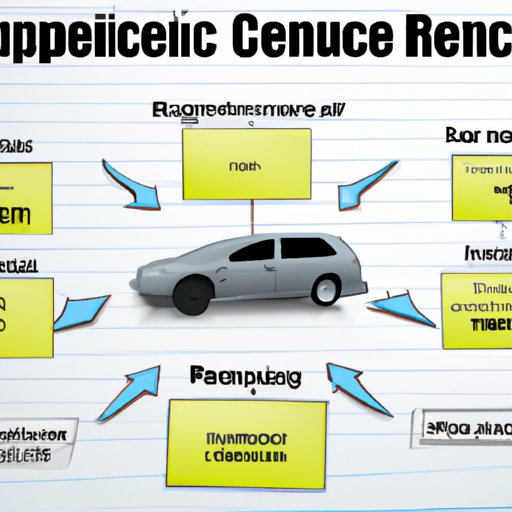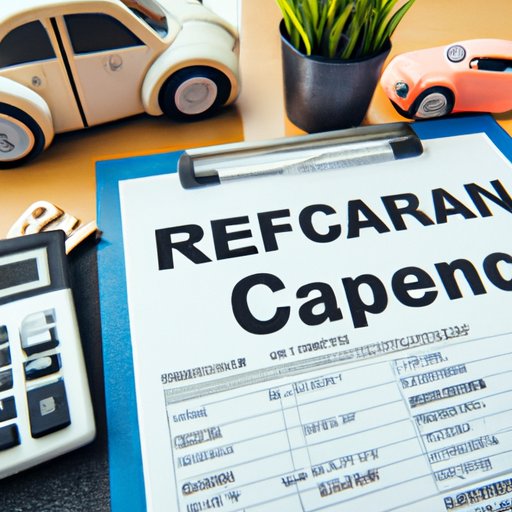Introduction
Car refinancing is a process that involves taking out a new loan to pay off an existing car loan. It is designed to help borrowers reduce their monthly payments or get a lower interest rate. But before you consider refinancing your vehicle loan, it’s important to understand how the process works and the potential benefits and drawbacks.
Explaining the Basics of Car Refinancing
What is Car Refinancing?
Car refinancing is the process of taking out a new loan to replace an existing car loan. The new loan pays off the balance of your existing car loan, leaving you with one loan instead of two. This can be beneficial if you can get a lower interest rate or lower monthly payments on the new loan.
How Does It Work?
When you refinance your car loan, you are essentially replacing your existing loan with a new one from a different lender. You will use the money from the new loan to pay off the balance of your existing loan. The new loan will have different terms than your old loan, such as a lower interest rate or a lower monthly payment.

Exploring the Pros and Cons of Refinancing a Car
Benefits
The primary benefit of refinancing a car loan is the potential to save money. If you can secure a lower interest rate or lower monthly payments, you could save hundreds or even thousands of dollars over the life of the loan.
In addition, refinancing can also help you build your credit. If you make on-time payments on the new loan, you may be able to improve your credit score.
Drawbacks
One of the potential drawbacks of refinancing a car loan is that it can extend the term of your loan. If you’re refinancing to get a lower interest rate, you may end up making payments for a longer period of time. This means you could end up paying more in total interest over the life of the loan.
In addition, refinancing can also cost money. Many lenders charge a fee for refinancing, which can range from a few hundred dollars to several thousand dollars. This fee is typically rolled into the loan amount, so you’ll end up paying interest on it.

Examining How to Qualify for Car Refinancing
Credit Score Requirements
Most lenders require a minimum credit score in order to qualify for car refinancing. According to Experian, the average credit score for those who are approved for auto loans is 713. However, some lenders may require a higher score, so it’s important to check with the lender to find out their specific requirements.
Income and Employment Verification
In addition to a good credit score, lenders may also require proof of income and employment. This is to ensure that you will be able to make the payments on the loan. Lenders may require recent pay stubs or tax returns to verify your income and employment.
Other Requirements
Other requirements vary by lender, but may include things like proof of insurance, a valid driver’s license, and a down payment. Depending on the lender, you may also need to provide additional documents such as bank statements or proof of residence.
Analyzing the Cost of Refinancing a Car
Interest Rate
The most important factor when considering the cost of refinancing a car loan is the interest rate. The lower the interest rate on the loan, the less you will pay in total interest over the life of the loan. Be sure to shop around to compare rates and make sure you are getting the best deal possible.
Fees
In addition to interest, lenders may also charge other fees for refinancing. These may include application fees, origination fees, or prepayment penalties. Be sure to ask about any potential fees before agreeing to a loan.

Outlining the Steps Involved in Car Refinancing
Finding a Lender
The first step in refinancing a car loan is finding a lender that offers competitive rates and terms. You can shop around online or visit local banks and credit unions to compare offers. It’s important to do your research and compare multiple lenders to ensure you are getting the best deal possible.
Applying for Refinancing
Once you’ve found a lender, you’ll need to fill out an application. This typically includes providing information about yourself, your income, and your existing loan. Be sure to read the terms and conditions carefully before signing.
Finalizing the Loan
After you’ve been approved for the loan, you’ll need to sign the paperwork and submit it to the lender. Once the paperwork is complete, the lender will send the funds to pay off your existing loan. You should receive a copy of the loan agreement for your records.
Conclusion
Summary of Article
Car refinancing can be a great way to save money on your car loan. Before you refinance, it’s important to understand the basics of car refinancing, the benefits and drawbacks, the cost of refinancing, and the steps involved in the process. By doing your research and comparing multiple lenders, you can find the best deal possible.
Final Thoughts
Refinancing a car loan can be a great way to save money if done correctly. By understanding the process and researching your options, you can find the best deal available and potentially save hundreds or even thousands of dollars over the life of the loan.
(Note: Is this article not meeting your expectations? Do you have knowledge or insights to share? Unlock new opportunities and expand your reach by joining our authors team. Click Registration to join us and share your expertise with our readers.)
